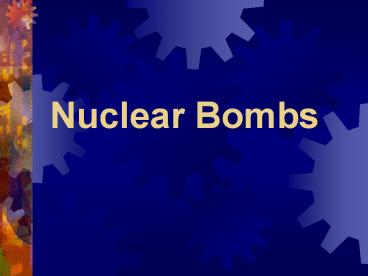Nuclear Bombs - PowerPoint PPT Presentation
Title:
Nuclear Bombs
Description:
Nuclear Bombs The First Nuclear Bombs There are two main types of bombs which release energy from the nuclei of atoms. The simplest kind is an atomic bomb. – PowerPoint PPT presentation
Number of Views:440
Avg rating:3.0/5.0
Title: Nuclear Bombs
1
Nuclear Bombs
2
The First Nuclear Bombs
3
- There are two main types of bombs which release
energy from the nuclei of atoms. The simplest
kind is an atomic bomb. Like a nuclear power
plant, it releases great quantities of energy
through a process called nuclear fission, or
'splitting', of a large unstable (radioactive)
element like uranium or plutonium.
4
- The energy source is a mass of radioactive
material such as uranium or plutonium. This
material is very unstable every atom's nucleus
is ready to fall apart ('decay') at the slightest
nudge, releasing unneeded energy and extra
neutrons. In the diagram, the plutonium (B) is
given that nudge by the outer casing of TNT (A),
which explodes all around it.
5
- The plutonium is unstable, or radioactive. Its
atoms are constantly 'falling apart', breaking up
into smaller elements that are more stable. Every
time one nucleus does this, it releases the extra
energy it no longer needs to hold it together, as
well as a few left-over neutrons. This energy,
and the escaping neutrons, is what we describe as
the radiation being emitted from the radioactive
plutonium. This energy and flow of escaping
neutrons can damage human cells, so radioactivity
is dangerous.Enough atoms in the chunk of
plutonium are breaking down at any one time to
make the chunk of plutonium warm up, but not
enough to be considered an explosion.
6
- What happens in the bomb, however, changes that!
The force of the TNT explosion causes the
plutonium to be squashed, or compressed in size,
and become very dense. This is called its
'critical mass' the plutonium is now so densely
packed together that the neutrons escaping from
the decaying nuclei of plutonium cannot escape
from the plutonium without bumping into another
plutonium atom!
7
(No Transcript)
8
- When they hit another atom, they cause that
nucleus to break down too, whether it was ready
to or not. That second nucleus releases more
energy, and more neutrons, which in turn go on to
hit and break up further nuclei. The decaying
nuclei cause more decaying nuclei, and so on, in
a rapidly escalating chain reaction ... and all
because the plutonium has been squeezed into such
a dense state (by the TNT) that the escaping
neutrons that normally would fly out of the
material now can't, without hitting other nuclei!
9
- Within a very tiny fraction of a second, all the
nuclei in the chunk of plutonium have been hit by
escaping neutrons, and have broken down. The
extra energy in trillions of atomic nuclei is all
released at once! This energy is considerable
the atomic bomb dropped on Hiroshima in WWII was
an example of this process.
10
(No Transcript)
11
(No Transcript)
12
(No Transcript)
13
Initial Explosive Conditions
- Maximum temperature at burst point several
million degrees centigrade. A fireball of
15-meters radius formed in 0.1 millisecond, with
a temperature of 300,000 degrees centigrade, and
expanded to its huge maximum size in one second.
The top of the atomic cloud reached an altitude
of 17,000 meters.
14
Black Rain
- Radioactive debris was deposited by "black rain"
that fell heavily for over an hour over a wide
area.
15
Damaging Effects of the Atomic Bomb
- Intense thermal heat emitted by the fireball
caused severe burns and loss of eyesight. Thermal
burns of bare skin occurred as far as 3.5
kilometers from ground zero (directly below the
burst point). Most people exposed to thermal rays
within 1-kilometer radius of ground zero died.
Tile and glass melted all combustible materials
were consumed.
16
Blast
- An atomic explosion causes an enormous shock wave
followed instantaneously by a rapid expansion of
air called the blast these represent roughly
half the explosion's released energy. Maximum
wind velocity 440 meters per second. Wooden
houses within 2.3 kilometers of ground zero
collapsed. Concrete buildings near ground zero
(thus hit by the blast from above) had ceilings
crushed and windows and doors blown off.
17
Bodily Injuries
- Acute symptoms. Symptoms appearing in the first
four months were called acute. Besides burns and
wounds, they included general malaise, fatigue,
headaches, loss of appetite, nausea, vomiting,
diarrhea, fever, abnormally low white blood cell
count, bloody discharge, anemia, loss of hair. - Aftereffects. Prolonged injuries were associated
with aftereffects. The most serious in this
category were keloids (massive scar tissue on
burned areas), cataracts, leukemia and other
cancers.
18
Radiation
- People exposure within 500 meters of ground zero
was fatal. People exposed at distances of 3 to 5
kilometers later showed symptoms of aftereffects,
including radiation-induced cancers.































